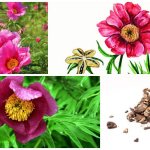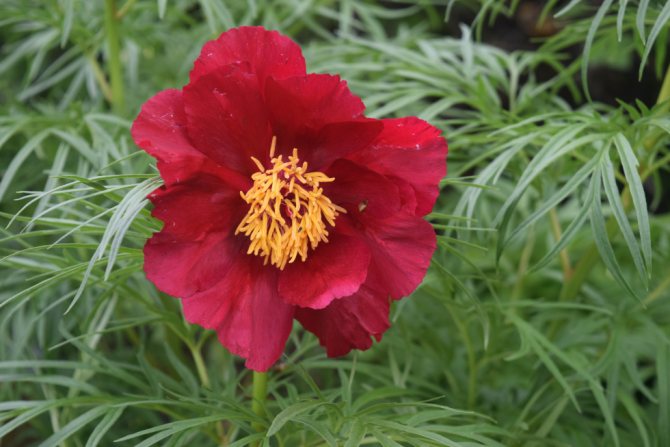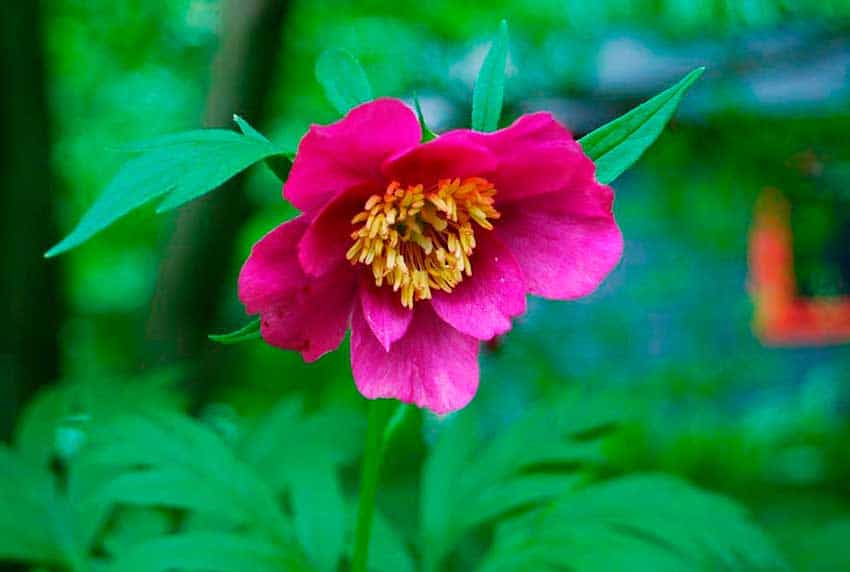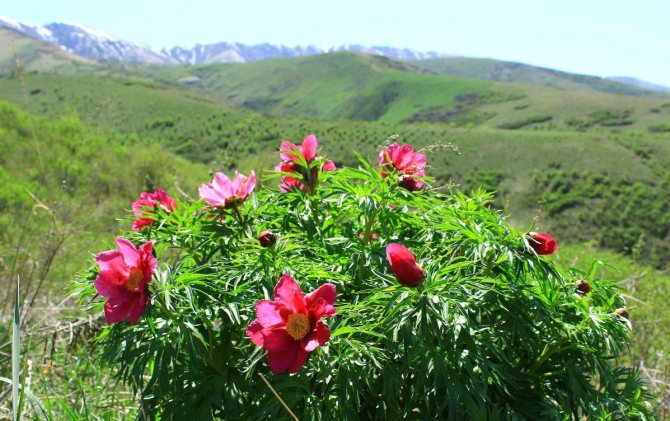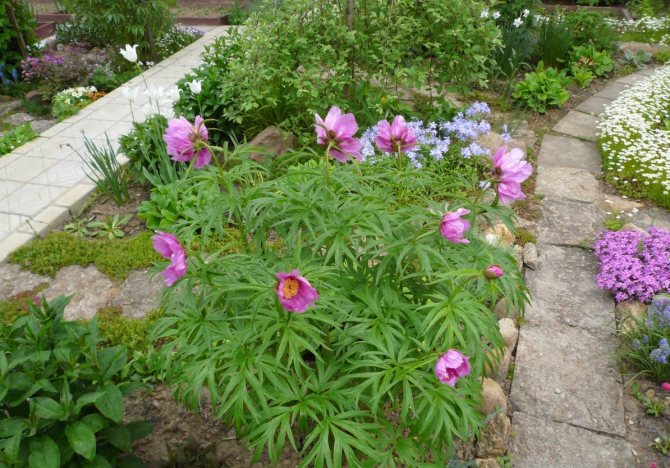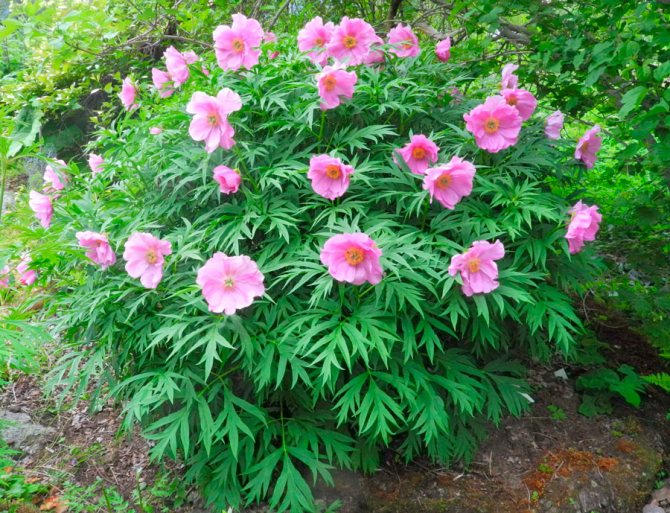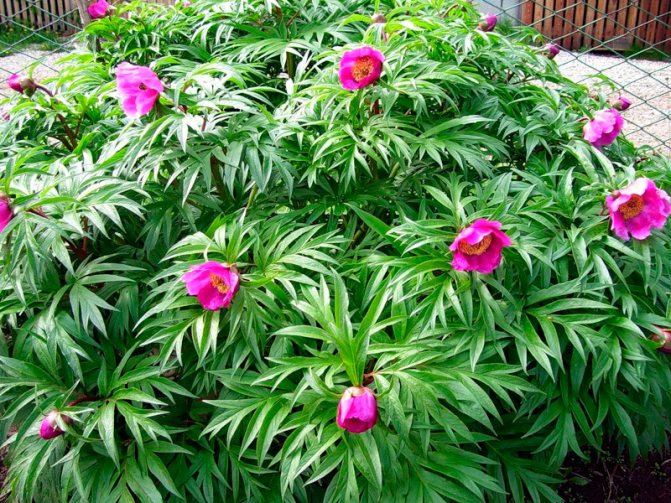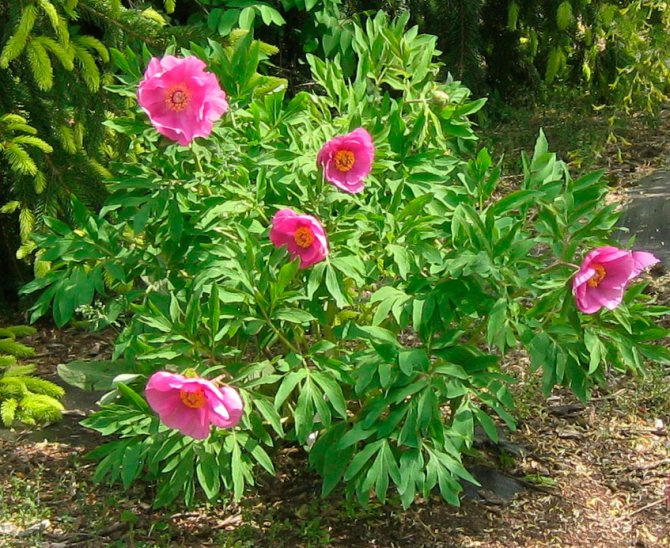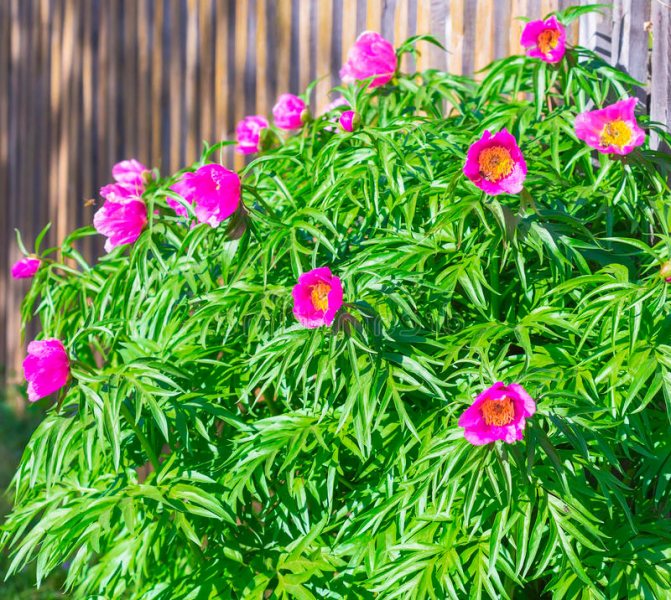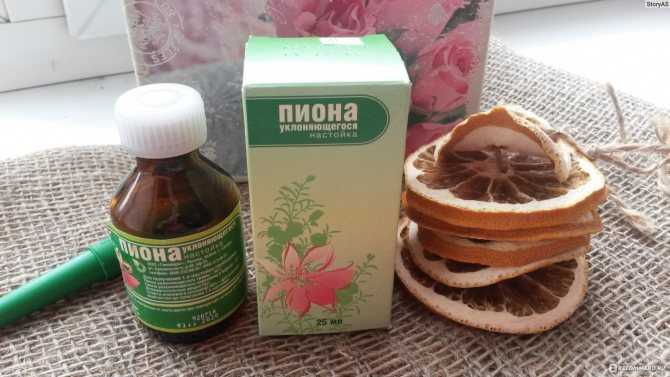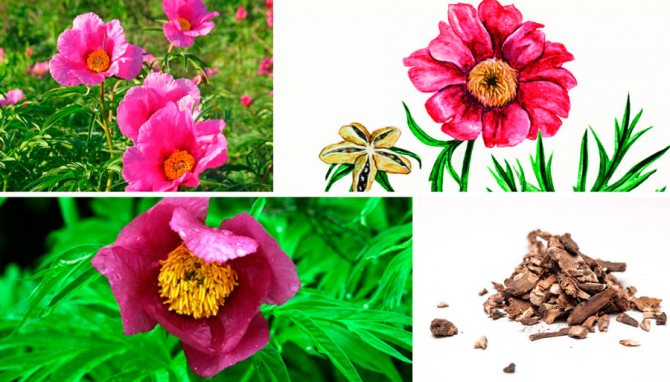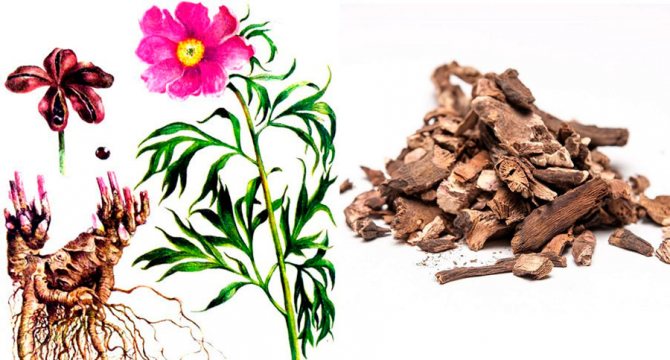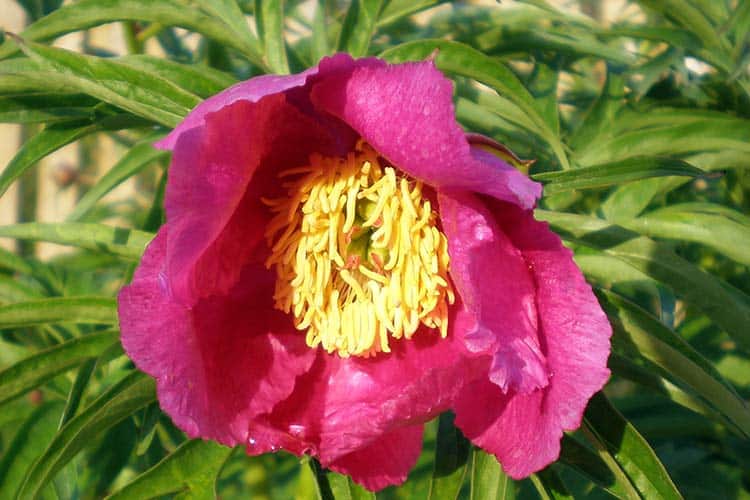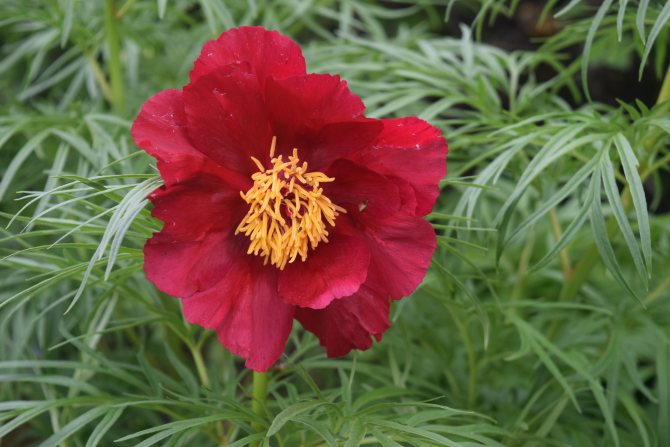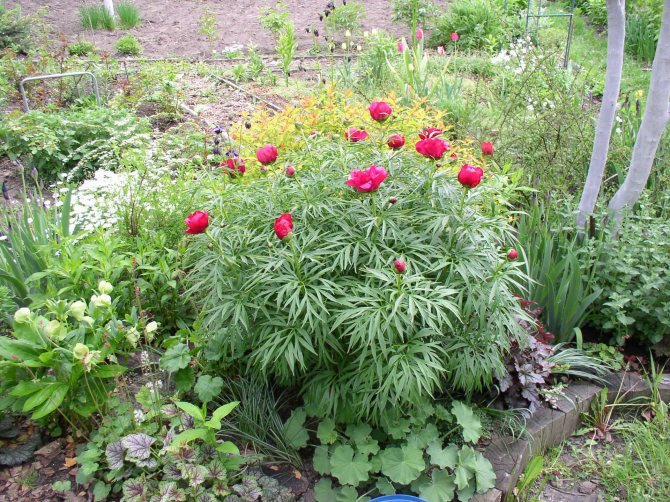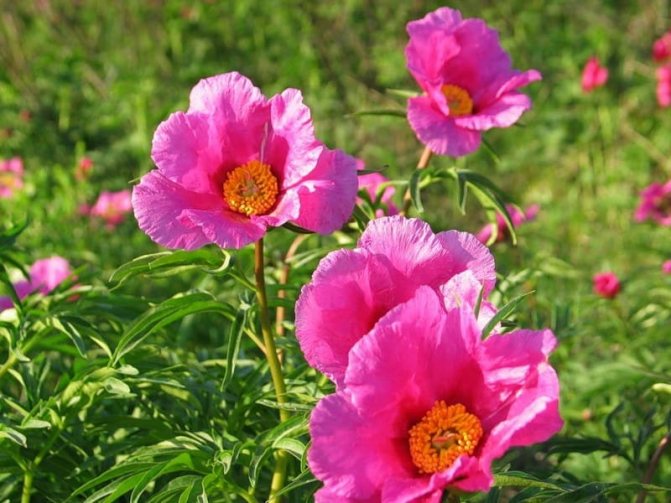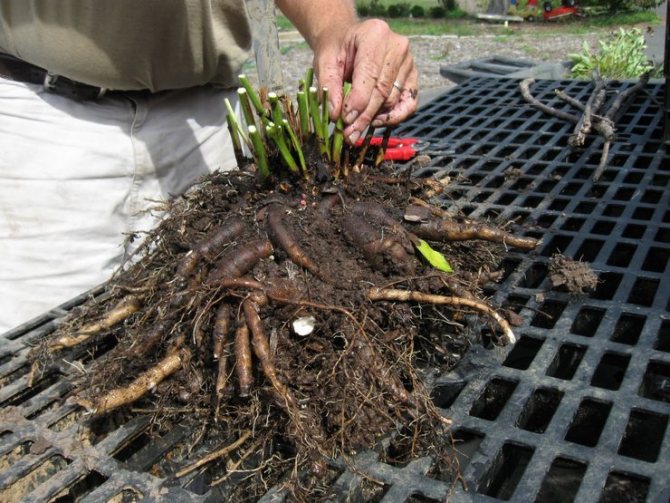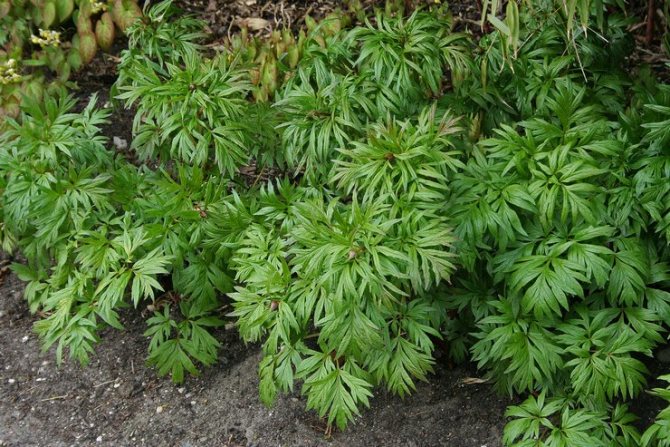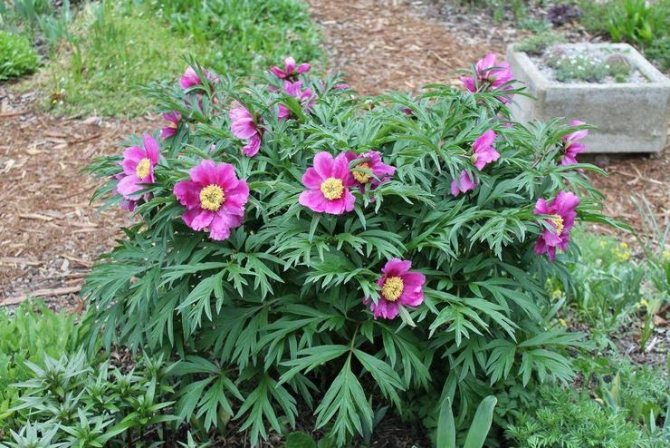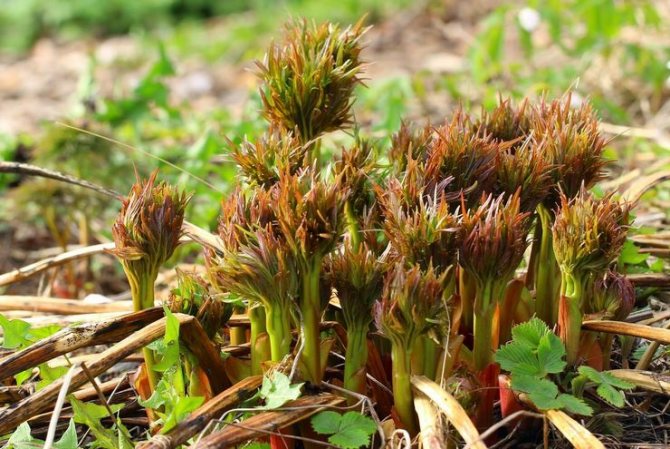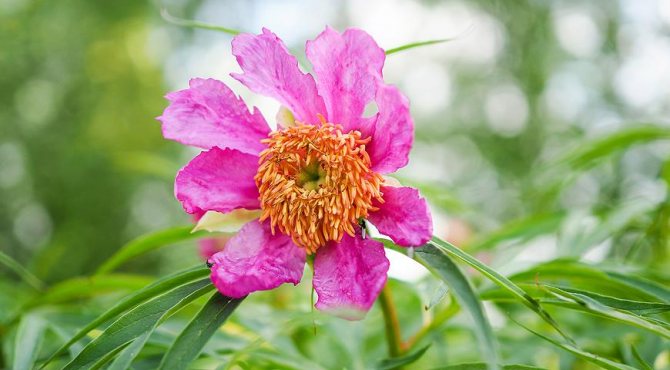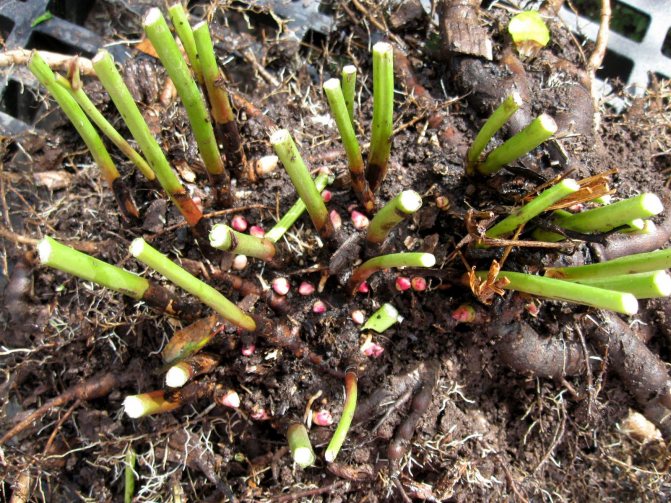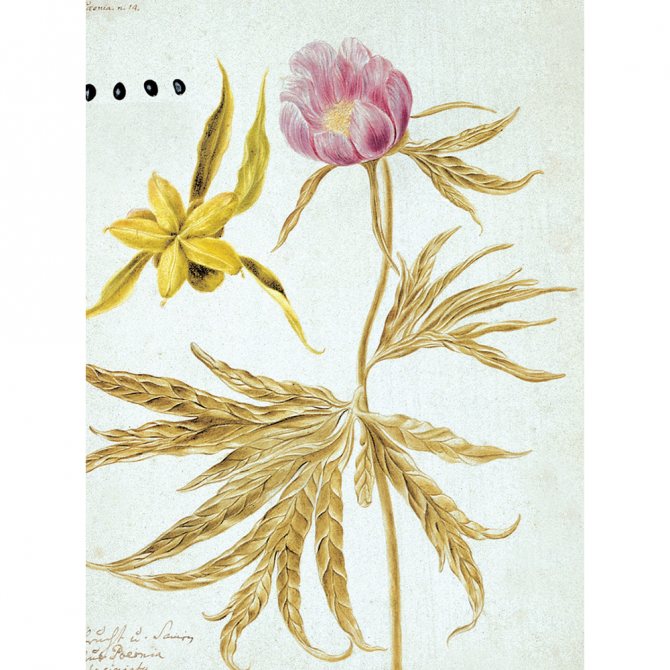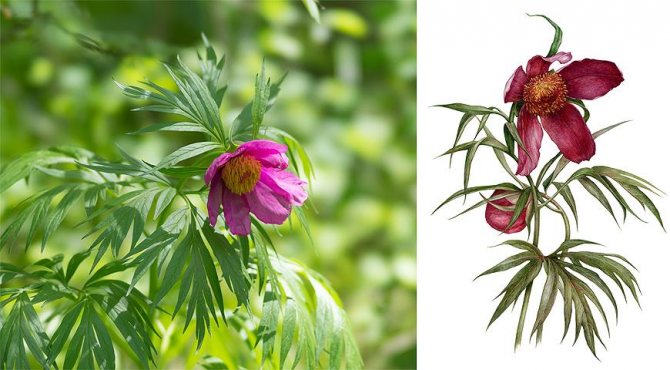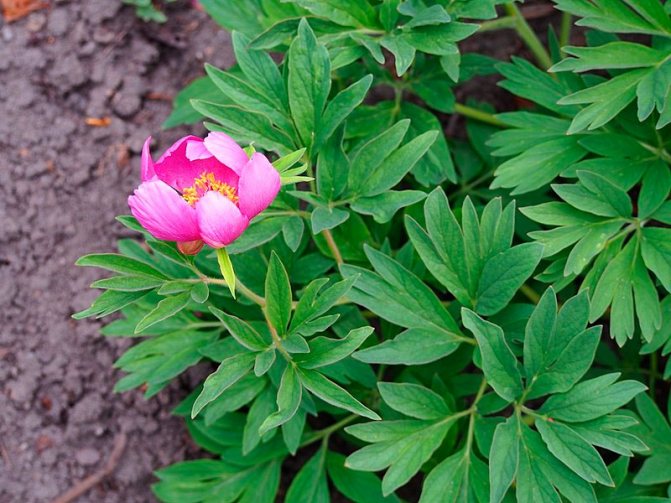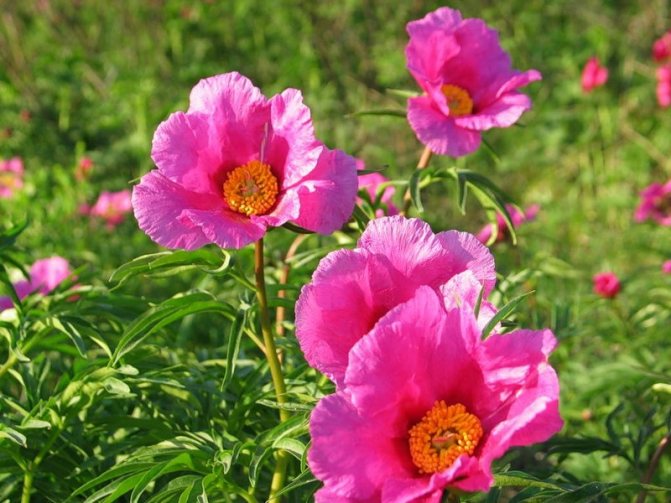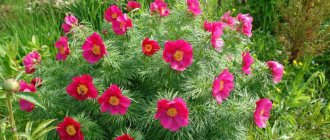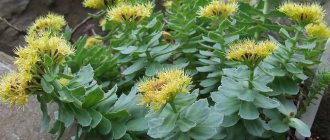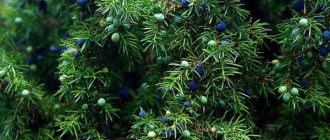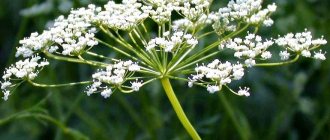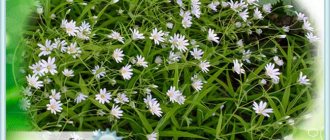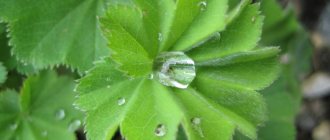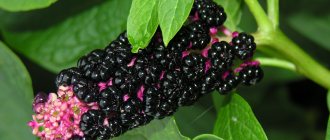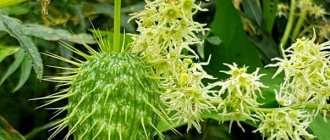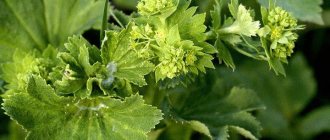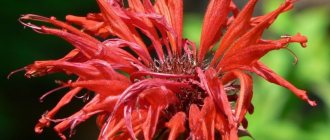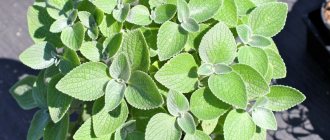Peony evading (Maryin root) Paeonia Anomala is a herbaceous perennial plant that belongs to the buttercup family. It has a horizontal root and fusiform tubers. Also this plant is characterized by thick stems. Peony leaves are alternate, they are dissected into lanceolate segments. The flowers of the plant are large and solitary, they can reach from 6 to 13 cm in diameter. The fruits of the plant are arranged in a star shape. As for the seeds, they are elliptical in shape.
Distribution area
The evading peony can be found in Central Asia, Transbaikalia, the northern regions of the European part of Russia, in the Urals and throughout the territory up to the Arctic Circle. This frost-resistant species is perfectly used to decorate the streets of Yakutia. Wild shrubs prefer lowland forests and humus-rich soils. It often grows in separate bushes, but sometimes there are small thickets. Peony is in the Red Book of Russia and Sakhalin and is considered an endangered species.
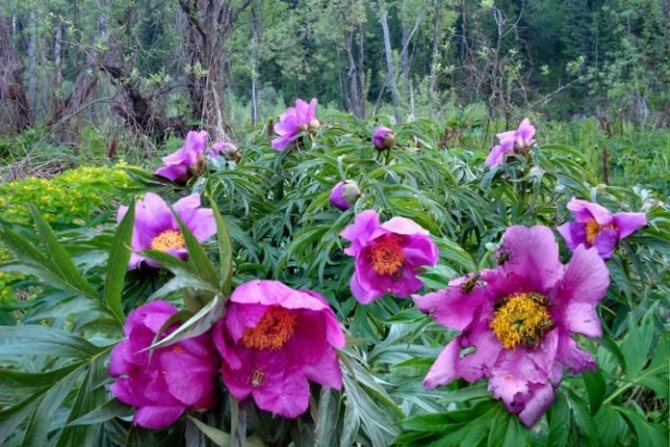
In horticulture, it is grown as an ornamental and medicinal flowering plant. It multiplies easily and is not susceptible to gray rot. The peony is able to survive in shaded areas of the garden plot and delight with lush flowering. Subject to the elementary rules of care in a permanent place, it grows up to 50 years. Every year (after May 15), the bush resembles a huge bright bouquet, which contains up to thirty charming flowers.
Care rules
To make your Maryin root quickly turn into a lush flowering shrub, carefully consider some of the requirements. Here are the main ones.
Watering
One bush requires 20 - 30 liters of water, so do not water often, but do not allow the soil to dry out either. Try to use only settled warm water.
It is especially important to give water to the bush when the period of bud development begins, and also in August during the time the flower buds are laid the next year. The soil, especially during these periods, should not be overdried.
Fertilizer
From the second decade of May, a young bush will need foliar feeding. Any universal mineral fertilizer will do (Ideal will do). Add 1 tbsp to it. l. laundry soap (for 10 liters of water).
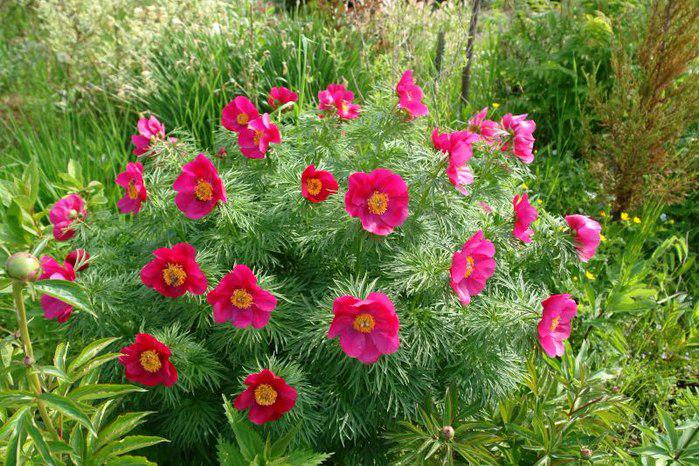

When the bush is already mature, it is necessary to fertilize it more - starting from the beginning of May at least 3 times every 20 days.
- First, the urea solution is 50 grams per 10 liters of water.
- The second time - urea is combined with micronutrient fertilizers - 1 tablet per 10 liters of water.
- The third time - 2 tablets of micronutrient fertilizers in a bucket of water.
We need a bush and root fertilizers no less. For the whole season, it needs to be fed at least 3 times.
- In the second half of March and until the first days of April, nitrogen and potassium (15 grams per plant) should be put on the soil. Together with melt water, nutrients will enter the root system.
- Before the flowering period, to increase the number of flowers, fertilizing should be complex: nitrogen - 10 g, phosphorus - 20 g, potassium - 10 g. Some are replaced with organic fertilizers: mullein solution (1: 10) or bird droppings (1: 25).
- After the peony has faded, around the bush, in a pre-dug groove, you need to pour a solution consisting of a mixture of potassium and phosphorus (15 g each).
Combine fertilizers with watering, then cover the groove with earth. Remember to loosen the soil regularly.
Description of the plant
Evasive peony, or Maryin root, is a herbaceous perennial plant, the height of which reaches one and a half meters, belongs to the Peony family. It has powerful, fusiform, tuberous roots of a reddish-brown color. When cut, they are white, in the air they quickly acquire a pink-brown hue, and the edge becomes lilac.
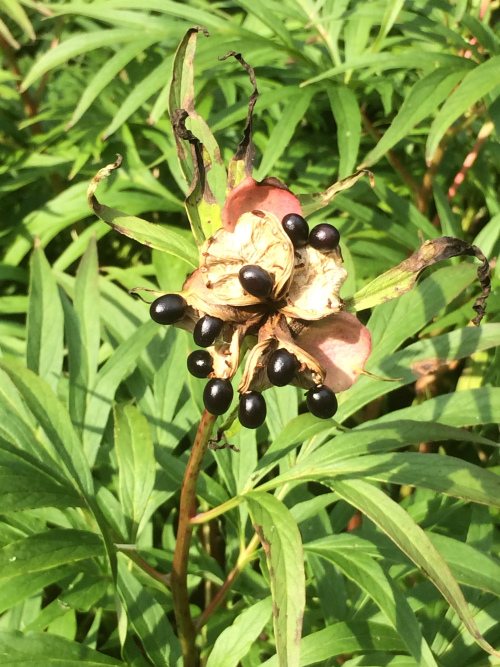

The taste of the roots is sweetish with a strong peculiar smell of methyl salicylate. The plant consists of several thick, erect, convex-ribbed, one-flowered stems, covered with leafy scales and colored pink-purple at the base. The leaves of the evading peony are alternate and petiolate, about 30 cm long. Flowers with pink-red petals, 8 to 13 cm in diameter, have a faint specific odor. Blooms in May-June. The fruit consists of 3-5 large, multi-seeded leaflets with a star-like arrangement. Seeds are black in color with a shiny surface, have an elliptical shape, up to 7 mm long. Fruit ripening occurs in the first decade of September. Propagated by rhizomes and seeds.
Plant care Maryina grass
It is easy to care for a peony evading. Even with minimal care, the plant will surely delight you with its flowers.
Watering and feeding
Peony Team Performance - cultivation of a variety in the garden
Maryin root does not need frequent watering, as its tuberous roots can accumulate moisture. During the growing season and at the end of summer, when flower buds are laid, 1-2 buckets of water should be poured under the bush. It is important to remember that roots can rot from excessive waterlogging. To drain excess moisture from the trunk circle, small grooves are made around.
Young plants are best fed with mineral fertilizers, applying them by the foliar method no more than 1 time per month. Adult bushes need additional nutrition three times per season. In the spring, the peony is fertilized with a urea solution, at the beginning of summer with the same composition with the addition of a mineral complex, after another 3 weeks, only minerals are added.
Mulching and loosening
The evading peony is protected from overgrowing with weeds and is regularly loosened after watering or rain. This will protect the plant from disease and provide oxygen to the roots. The loosening depth should be 5-15 cm.
Attention! Mulching is done only in the year of planting. The space around the bush is sprinkled with a mixture of peat, humus and sand.
Preventive treatment
To scare away insect pests from Maryin, it can be sprayed with fungicidal preparations in the spring. It will not be superfluous to shed the soil in the near-trunk circle with a solution of Bordeaux liquid.
Harvesting raw peony
The whole plant is used as a healing agent. For the effective use of the healing qualities of the evading peony, it is necessary to properly collect and dry the raw materials. The grass of the plant (buds, leaves and stems) is cut in July with a sharp knife. The petals are harvested before they fall off. All collected raw materials are dried in a well-ventilated area under a canopy. After drying, they are crushed and stored in linen bags. It is better to put the petals in dark boxes. The roots are allowed to be harvested throughout the growing season, but experts recommend that this procedure be carried out in the fall, when a large amount of healing substances accumulate in them.
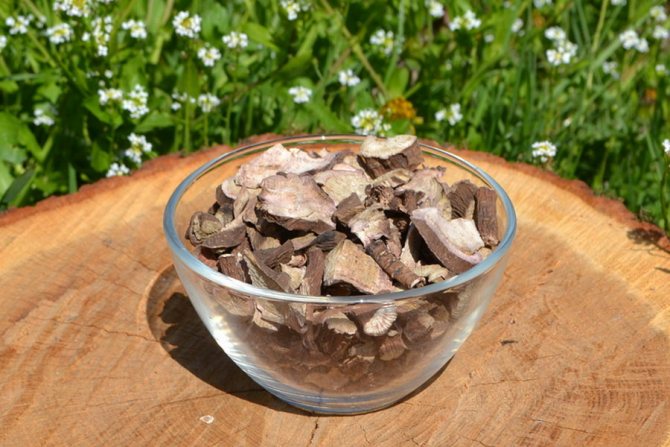

The roots are cleaned from the ground, washed with cold running water and cut into pieces 10-15 in length and two to three centimeters thick. Drying of the underground parts of the peony (Maryina root) is carried out under a canopy in the air until they become brittle. Then they are finally dried in a drying chamber at a temperature of 45 to 60 degrees Celsius.After readiness, the raw material has a pungent odor, sweetish, astringent taste and a dark brown or brownish yellow color. The shelf life is three years. In one place, the preparation of a peony is carried out every 5-6 years. The roots and the aerial part are dried separately.
Planting and leaving
Maryin root has been cultivated in gardens since the 18th century. At first, it could be seen only in botanical gardens, but now an ornamental plant adorns the landscape of summer cottages, gardens, parks. Peony is unpretentious and resistant to various weather conditions. There are several rules to help you grow a lush flowering bush:
- The flower prefers light open areas. You can plant a peony evading in the shade of trees, but lush flowering and large buds will not work.
- Maryin's root should not be planted in places where rainfall or snow melts are collected. A site with a close occurrence of groundwater is not suitable. From excess moisture, the root rots.
- Another important condition is protection from drafts and strong winds.
- Peonies need loose, fertile soil with a neutral pH or mild alkaline reaction. If the site has heavy clay soils, the situation will be corrected by adding sand - 1 bucket in each hole. Dolomite flour helps to reduce acidity. It will take from 300 to 500 g.
- Plant and replant flowers in late August or early September. They will have time to take root, but the buds will not grow.
- The distance between the seedlings is not less than 70-100 cm, because soon they will turn into spreading bushes.
Advice. Prepare a bed for evading peonies in advance. During this time, the soil will settle, the components will mix well, the fertilizer granules will begin to dissolve.
Preparing a landing site
In rare cases, the land on the site has all the components necessary for the full development of plants. For planting peonies, the soil is prepared in 2-3 weeks. Plants remain at one 10-15 years, therefore it is necessary to prepare thoroughly for their cultivation. A spacious hole is dug with a size of 70:70:70 cm. At the bottom, drainage is arranged with a layer of up to 10 cm, which helps to drain excess moisture. Broken brick, pebbles, expanded clay will do. On sandy soils, green growth is good and flowering is weak. The addition of clay will be required.
As components of the planting soil, you will need:
- organic matter - compost and rotted manure;
- minerals - superphosphates and potassium 150-200 g;
- ash - 100-150 g.
Half of the soil is mixed with mineral fertilizers and filled up for drainage. The second part, together with organic matter, falls asleep on top of the seedling. When placing the root, it is necessary to take into account the requirement - the soil layer above the buds is no more than 3-5 cm. After planting, the plant is watered abundantly.
Agrotechnical cultivation
The roots of the dodging peony accumulate water and nutrients, so the plant requires rare but abundant watering. In the absence of natural precipitation, the bush is moistened once a week. Drought leads to the setting of small buds. Without watering at the end of summer, you should not count on abundant flowering next year.
Loosening of the soil is a very important procedure in the first 3 years of development of Maryina root. The plant needs regular air exchange. The weeds near the flowers are immediately pulled out. It is advisable to break up the crust of the earth after each rain. In the fall, the stems are cut to soil level. Peony evading in natural conditions is widespread in the northern regions, it is frost-resistant and does not require winter shelter.
Like all ornamental crops, the flower requires fertilization. Bushes are fed 3 times per season. The first fertilizers (nitrogen) are scattered in early spring. The second and third feeding (superphosphates and potassium) is carried out before and after flowering.
The content of nutrients in the plant
The rhizome and stem of the peony contain the following organic matter:
- Salicylic acid is a natural anti-inflammatory agent.
- Glycosides are carbohydrates of plant origin of the evading peony, the therapeutic effect of which ensures the correct functioning of the cardiovascular system.
- Flavonoids - Help the production of estrogen during menopause.
- Essential oils - contribute to the normalization of the central nervous system, providing a sedative effect.
- Benzoic acid is a natural antibacterial agent that destroys fungi, viruses and pathogens.
- Minerals - the plant contains most of the salts and minerals necessary for the normal functioning of the individual's body.
All of the above substances have a beneficial effect on maintaining the body in a working condition.
Where grows
The species is common in Russia on the territory of Siberia, found in Kazakhstan, Mongolia and China. In the European part of Russia, it can be found in the Perm Territory, the Komi Republic (in the upper reaches of the Vychegda, Ukhta, Pechora Pizhma, Pechora, Ilych rivers; in the river valleys along the Pechora Lowland and the Mezensko-Vychegodskaya Lowland) and on the Turiy Peninsula.
The plant grows in light mixed forests, meadows and forest edges, in river valleys. Prefers fertile, moderately moist, rich soils, sunny places. In the mountains, the plant can be found up to the subalpine belt. Does not tolerate grazing. The yield of rhizomes and roots reaches 5-10 c / ha.
It belongs to rare plant species, and in some regions it is considered endangered. The plant is noted in the Red Book of Animals and Plants of the Republic of Kazakhstan and the Republic of Komi.
The healing properties of the evading peony
The plant has many medicinal substances, therefore preparations based on it are used for:
- Relief of spasms and seizures - normalization of nerve impulses occurs due to anticonvulsant and antispasmodic properties at the same time.
- Pain relief - used to suppress painful sensations of various origins.
- Relief from nervous excitability - Acting as a natural antidepressant, it helps to quickly relieve depressed mood and fatigue.
- Normalization of the circulatory system - due to the hemostatic properties, blood loss is reduced, and wounds heal quickly.
- Destruction of bacteria and viruses - natural antibiotics actively fight against pathogenic microorganisms and are used to treat inflammation of various kinds.
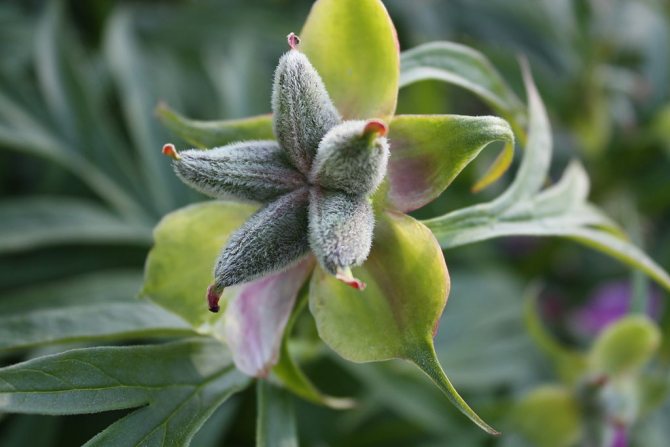

In addition, the properties of the evading peony are used to stimulate metabolic processes, increase the acidity of the stomach, prevent and treat malignant neoplasms, increase efficiency, treat dermatitis, and prevent alcoholism.
Peony evading: description, useful properties, application and contraindications
One of the main versions of the origin of the name of this plant - "peony" - is as follows. Peony, a disciple of the very experienced and wise healer Asclepius, healed not only people, but also gods with his medicines. So, the god of the underworld, Hades, during a fight with Hercules, was seriously injured, which could cost him his life. Then he asked for help from Peony. Peony, from the hands of the mother of the god Apollo, who was the goddess of darkness, received Leto. Asclepius was jealous of Peony, so he ordered to secretly kill the young man. Hades, saved by Peony, learned about this in time, who, in order to save his healer from death, turned it into a flower, which has since then been named Peony, possessing not only proper beauty, but also many healing properties.
Content:
In other countries, the evading peony was also called the maria root. There were also legends about Mary's root. It was believed that the plant is endowed with magical properties.There was even a belief that if small pieces of peony were put on a thread, which was then tied around the neck, then this would be a sure remedy for damage and the evil eye.
Related article: European olive - useful properties, description
Biological description of the evading peony
Evasive peony, peony, heart berries, Marya korevna, Maryin root, Zhgun-root (lat. Paeonia anomala L.) Is a perennial herb, reaching a height of 1 meter or slightly more, belonging to the Peony family (Paeoniaceae).
The plant has a powerful rhizome, several grooved stems.
The root is brown, branched, has thick spindle-shaped tubers. On the cut, the rhizome is white, sweetish in taste, and emits a strong pleasant smell.
The leaves of the evading peony are large, pinnately dissected, up to 20 cm long.
The flowers are large (up to 13 cm in diameter), solitary, their color ranges from pink to bright purple. The flowering period is May-June.
Peony fruit - leaflet.
Spreading the dodging peony
Occasionally, it can still be found in the forests of the European part of Russia, Siberia, Mongolia, Kazakhstan and China. It is relatively well distributed in the Perm Territory and the Komi Republic, but even there the plant is considered rare and subject to protection (the dodging peony is listed in the Red Book of the Komi Republic, as well as in the Red Book of Kazakhstan).
Procurement of Evasive Peony Raw Materials
For medical purposes, the rhizomes of the plant are mainly used. The largest amount of nutrients is found in a 3-4 year old plant.
Rhizomes are harvested both in spring, before the beginning of the growing season, and in autumn after the herbaceous part dies off.
So that the plant can resume as quickly as possible, the entire bush is not dug up. Around the plant, you need to dig a groove, about one shovel bayonet deep. Then, with the help of the central part of the bush, the soil is washed off, and the rhizomes are exposed. From the rhizome, you can cut off a large part, about 2/3, and sprinkle the cut with crushed charcoal, and only then cover it with earth. In this case, you need to try at all costs to keep the main root intact. Coal will not allow penetration into the root of the infection, and the plant will fully recover in 1-2 years. After a couple of years, the harvesting procedure from one bush can be repeated exactly the same way.
The excavated roots should be cleaned of soil and dirt, rinsed with cold water, cut into pieces 2-3 cm thick and 10-15 cm long, and then dried without heating (in well-ventilated rooms or in the shade). But you can dry the roots in the oven, but at a temperature not higher than + 60 ° C.
You can not dry the roots of a peony evading in unventilated residential areas, as this can lead to headaches in people who are there.
Peony grass is also used for the preparation of preparations, but it should be harvested during the flowering period of the plant.
The chemical composition of the dodging peony
The rhizome and roots of the evading peony are mainly of medical importance, which contain:
- benzoic and salicylic acids,
- glycoside salicin (main active ingredient),
- flavonoids,
- saponins,
- sugar (up to 30% of the mass of the rhizome, mainly glucose), starch (up to 80% of the mass of the rhizome),
- tannins, tannins,
- essential oil (up to 1.5%) containing peonon,
- some alkaloids.
Useful properties of the dodging peony
The most important useful property of the evading peony is that it is the so-called adaptogen. When using drugs from it, the process of recovery from various diseases is accelerated by the creature. It has long been established that cancer patients even tolerate chemotherapy much easier if they simultaneously take a tincture of the evading peony.
Indications for use
The positive effect of using a medicinal plant has been noticed for a long time.The plant is successfully used for the following pathological conditions:
- Dysfunctions of the autonomic nervous system - neuroses of various origins, vegetative dystonia.
- Gynecological - in the treatment of menopausal symptoms, menstrual irregularities, benign and malignant formations in the uterus.
- Heart and blood vessels - in the complex treatment of hypertension, as well as heart ischemia.
- Chronic alcoholism - used as a sedative.
- Mental - for the treatment of seizures in epileptic seizures, depression, stressful situations.
- Central nervous system - relieves irritability and tension, fears, increased anxiety, helps to cope with fatigue.
- Urology - problems with urination.
- Gastrointestinal tract - stomach ulcers and duodenal ulcers, gastritis, diarrhea.
In addition, peony is used in the treatment of lichen planus, an exacerbation of which occurs in case of nervous disorders.
Peony in medical practice in different countries
Tibetan medicine widely uses peony for colds, nervous, gastrointestinal diseases, diseases of the lungs and respiratory tract, metabolic disorders, fever, it is considered an excellent way to enhance the contraction of the uterus.
In Chinese medicine, peony is part of the antitumor preparations.
For diseases of the kidneys and liver it is used in Mongolia.
In Tatarstan and Altai, the fried roots of the plant are used as tea leaves.
Some peoples of Siberia use peony roots for meat dishes as a seasoning.
In Kazakhstan, they are used for the preparation of various cereals.
The evading peony serves as a raw material for the manufacture of the drink "Baikal".
Contraindications for the use of the plant
Before using any plant, an adult must be sure to familiarize himself with the medicinal properties and contraindications. The evading peony is not recommended for use if the patient has:
- Arterial hypotension - pressure less than 120 mm Hg. Art., since taking the plant will aggravate the situation.
- Increased acidity of the stomach - peony-based preparations promote the production of hydrochloric acid and gastric juice, increasing acidity.
- The liver functions are impaired - there will be no complete neutralization of the body from plant components.
- Kidney diseases have been identified - plant substances with poor kidney function will accumulate in the body, causing side effects.
- Pregnancy and breastfeeding of a child - Maryin root belongs to poisonous plants.
- Allergy - it is quite possible that the body's reaction to substances contained in the plant increases.
In addition, it should be noted that taking medications can cause apathy, drowsiness, slow reaction, decreased attention, nausea, vomiting, abdominal pain and irritation of the gastric mucosa.
Origin story
Peony is the king of flowers. The Chinese revered him most of all, since early times there is a belief about the healing power of the plant. In China and Ancient Greece, the peony is a symbol of longevity, wealth and prosperity. The Romans and Greeks used the bushes of the Mary's root both for treatment and for decorative purposes. To drive out demons or heal the possessed, the rhizomes of adult shoots were used, from which healers made beads and put them on the patient's neck.
According to legend, the flower is named after the doctor Peon, who cured Pluto (the god of the kingdom of the earth) from the attack of Hercules. Aesculapius, who is the medicine man's teacher, was very jealous of the successful student and made an attempt to poison the ward. To avoid a painful death, Peon begged the gods to save his life. The rulers of the world took pity on the poor doctor and turned the doctor into a flower. It is believed that it was by this transformation that Peon eluded his teacher.
Due to its sweetish taste and tart smell, the ancient Chinese used the burning herb in the culinary arts. In the medicine, only the shoots of a purple flower are used.
Using factory forms from extraordinary peony
In pharmacies, you can buy several medicines made from peony:
- dry extract in tablets;
- vegetable raw materials in briquettes;
- alcohol tincture.
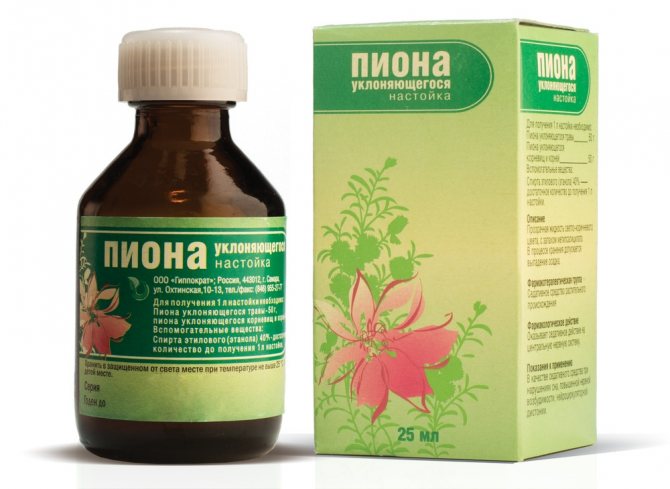

All forms are classified as sedatives, the most popular of which is alcohol tincture. It has a long shelf life, it is convenient to use it for a long course of treatment, external use is possible. In addition to its calming effect, it has:
- pain relievers;
- tonic;
- anti-inflammatory;
- bactericidal;
- fortifying;
- antimicrobial;
- antispasmodic;
- anticonvulsant.
Plant propagation
Maryin's root reproduces quite simply. There are three ways to reproduce it:
- seminal;
- cuttings;
- division of the bush.
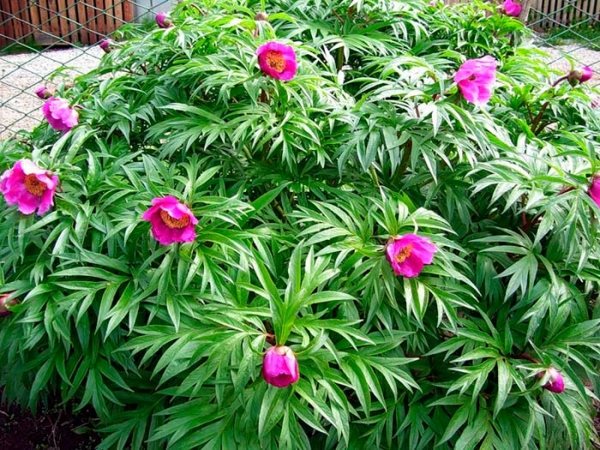

It is more convenient to propagate the marin root by dividing the bush
All these methods are quite successfully used by gardeners. But when propagated by seeds or cuttings, the peony will bloom only after a few years. Therefore, the division of the bush is more often used. An adult strong plant must be cut off, carefully removed from the soil with a lump of earth, rinsed with water and carefully divided into parts with a sharp knife so that each has several buds. Before planting in the ground, the separated parts of the rhizome must first be disinfected in a solution of potassium permanganate. Then it is better to treat them with a stimulant, for example, the "Kornevin" remedy.
Using the tincture
Given the beneficial properties of the evading peony, the use of the tincture is indicated for:
- Functional disorders of the central nervous system - relieves nervousness, chronic fatigue, bouts of anger and irritability. Helps with autonomic dysfunction, sleep disturbances, cerebral palsy.
- Digestive disorders - taken for gastritis with low acidity, spasmodic pain, diarrhea, loss of appetite, intoxication.
- Diseases of the respiratory system - recommended as an expectorant, drink for bronchitis, pneumonia, tuberculosis.
- Gynecological pathologies - helps with mastopathy, uterine myoma, infertility.
- Normalization of water-salt balance - used to remove excess salts in case of joint diseases, normalizes metabolic processes.
- External skin diseases - as an antiseptic and antimicrobial agent for the treatment of erosions, abscesses, cracks, ulcers.
In case of an overdose, the pressure drops sharply, drowsiness and lethargy, dizziness and nausea occur. When these symptoms appear, it is necessary to urgently stop taking the tincture and seek help from a medical institution.
Used for medical purposes
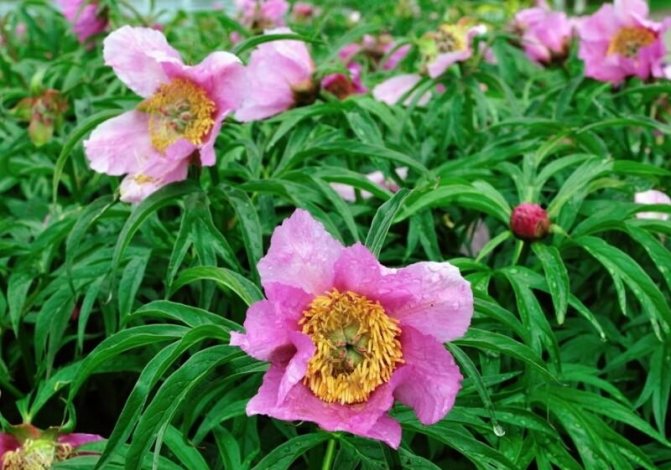

After flowering, star-shaped seed pods are formed on the peduncles. Photo: Peony evading - photo and description of the variety:
- Evasive peony (lat.Paeonia anomala L.) or Maryin root - a perennial medicinal plant. In addition, it is decorative and has medicinal properties. The plant belongs to the buttercup family, has a horizontal root with spindle-shaped tubers. Stems are thick, leafy. Leaves are alternate, dissected, lanceolate.
- Flowers are large, single, 8-13 cm in diameter, bright crimson color. The petals are arranged in one row around the pompom of yellow pollen-strewn stamens. After flowering, a star-shaped seed pod with an elliptical seed forms on the stem.
- Maryin root is widespread practically throughout the country. It can be found on forest edges and in the mountains of the Komi Republic. Prefers to grow in full sun or partial shade on loose and clayey soils. Blooms on average during the month in June.
- The plant is widely used for medicinal purposes, both independently and is part of many medicines.The whole plant, root and aerial part are used as a medicine. The peony is harvested during flowering, separating the root and leaves. The dried parts can be stored for no more than 5 years.
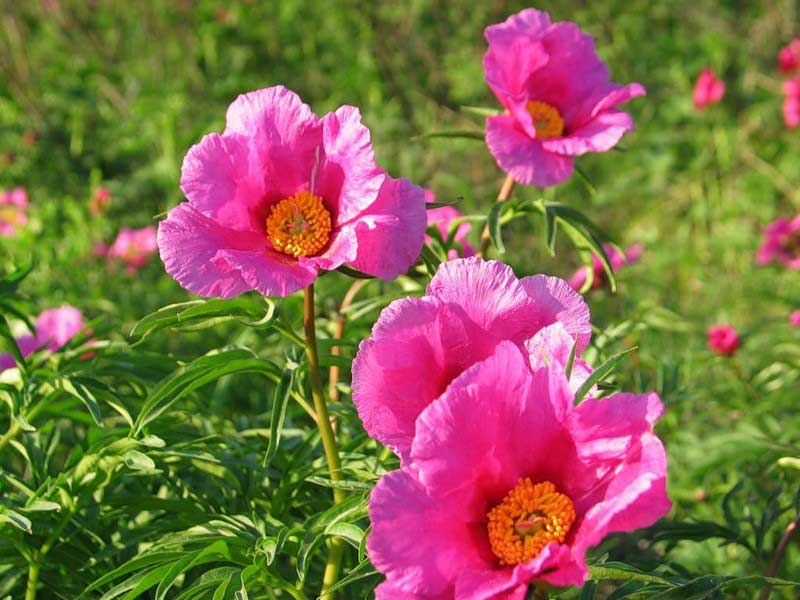

The bright flowers are called drooping heads. Photo:
The author of the video warns that the Evasive Peony is a poisonous plant. Therefore, when used for medical purposes, the correct dosage should be observed:
Peony evading: instructions for use
For the preparation of the tincture, the herb, rhizomes and roots of the plant are used; ethanol is used as an auxiliary substance. Release form - bottles made of orange glass with a capacity of 25 and 50 ml. They are equipped with a dispensing attachment and are packed in a cardboard box. Consider the instructions for using the tincture as a sedative for neurasthenia and sleep problems:
- Adults take 15-20 drops two to three times a day a quarter of an hour before meals. The duration of the treatment course depends on the individual characteristics of each patient and the severity of the disease, on average it is two weeks. If necessary, the treatment is repeated after a break of two to three months after consulting a doctor.
- Side effects - general weakness, drowsiness, lowering blood pressure, allergies.
- Contraindications - renal and hepatic failure, intolerance to the components of the drug, not recommended for children under twelve years of age, pregnant and lactating women.
- Special instructions: when using the tincture, you should refuse to drive vehicles and work with dangerous mechanisms. Long-term use in high doses causes an increase in gastric acidity. A sediment forms during storage, therefore, the contents of the bottle must be shaken before use.
- Drug interaction - the tincture weakens the effect of tonic agents of the central nervous system and enhances the effect of antispasmodics, hypnotics and sedatives. Ethyl alcohol can change the effect of other medicines taken at the same time.
- Dispensing conditions - the drug is dispensed without a prescription.
- Shelf life - the shelf life of the drug is two years, when stored in a dark place and at a temperature of no more than 25 degrees Celsius.
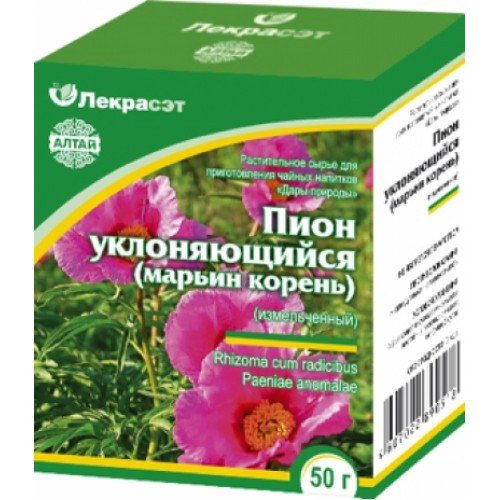

When using tinctures for the treatment of other diseases, the dosage of the drug is indicated in the instructions of the evading peony. And before using it, you need to consult with a specialist.
Planting Mary's root
Before planting, you need to choose a favorable place for the flower. This so-called stinging grass does not like the sun, the color quickly fades in direct sunlight. It is better not to plant bushes along fences and in the shade of a house. The best landing option would be an open area with little shading and no gusty winds.
It is not necessary to buy new shoots or seeds of wild peony every time. After flowering, seed pods are formed. Through the holes, you can easily see black embryos, calmly pick a new crop and plant at your own discretion.
Before planting, the fruits must undergo stratification, that is, after harvesting, they are placed in the refrigerator and kept in this state all winter. In February or March they are planted in the ground. This kind of freezing can be done in another way. In the autumn, the seeds are sown in a specially designated place for future flowers. In winter, they naturally freeze, and in spring they thaw and germinate.
To grow Maryin root from seeds, it must be borne in mind that this is a long process. According to many gardeners, the plant does not grow well in the spring. It happens that seedlings make their way two years after planting. Therefore, if it is necessary to select bushes in a quick way, then it is better to choose the option of dividing the rhizomes.
The use of peony in traditional medicine: recipes
At home, tinctures, infusions and decoctions are prepared from peony for anesthesia, relieve seizures. In addition, it is used as a bactericidal agent, as well as to stimulate the production of hydrochloric acid, which improves appetite and many other purposes. Preparation of medicines:
- Infusion. For three cups of boiling water, take a teaspoon of dry roots. Insist, tightly wrapped, drain. Use a quarter of an hour before meals three times a day, a tablespoon.
- Infusion for compresses. Pour a tablespoon of crushed dry roots with a glass of boiling water, put in a water bath for 15 minutes, cool, strain and make compresses for skin diseases.
- Broth. Mix in equal proportions the crushed dry roots and leaves of the duck peony. Pour 0.5 liters of boiling water over one coffee spoon of raw materials. Boil over low heat for five minutes and drink a coffee cup three times a day.
- Tincture. Dry roots (10 g) insist on 100 g of vodka for three weeks in a dark place. Take 30 drops three times a day. The course of treatment is a month. If necessary, repeat after ten days off. Keep refrigerated.
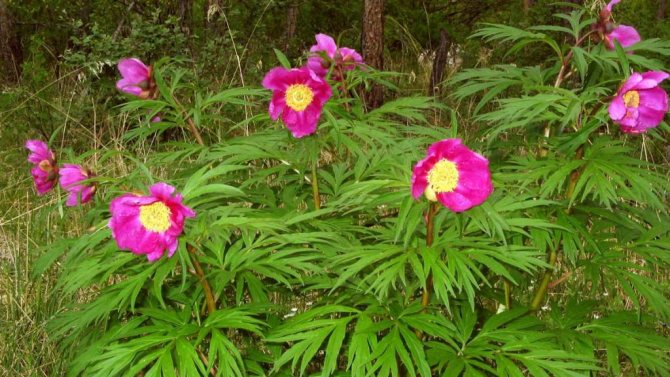

Consult your doctor before use. For funds from a peony evading contraindications are liver and kidney diseases, allergies, age up to 12 years, pregnancy and breastfeeding.
How to properly plant and grow a flower in the open field
The evading peony propagates by rhizomes and sowing seeds. The main condition is adherence to agricultural technology. The first option is much easier and faster, which is why gardeners prefer it.
Planting with rhizome cuttings
DIY pine bonsai in the garden
The bush is carefully removed from the ground, the soil is cleaned from the roots and divided into several, approximately equal parts. Each of the divisions must have its own roots and 2-5 pieces. kidneys.
What time is the boarding
The procedure is carried out in the autumn. It is important to take into account that the plant should have enough time to adapt to a new place within 30-45 days before the onset of frost.
Location selection
Maryin root is a wild plant, not too picky about the composition of the soil and external conditions. For the plant, open to the sun, as well as shaded areas protected from drafts, are suitable. The bush takes root very well under trees.
How to prepare the soil and flower for planting
Delenki are dried in the fresh air by treating the root sections with ash. The site for planting is dug up with the addition of superphosphate and potassium, as well as river sand, which gives the soil looseness.
Planting procedure step by step
Mar'in root is planted on a site prepared in advance. The instructions for the landing sequence are as follows:
- For each seedling, dig holes with a diameter of at least 50 cm and a depth of 2 bayonets of a shovel.
- A drainage layer is placed at the bottom of the pit.
- The holes are half filled with a soil mixture prepared from equal parts of humus, sand and garden soil.
- The bush is placed in a hole, gently spreading the roots, and covered with earth.
- The planted plants are watered.
In the first years after planting, the bush is regularly pinched so that it has the opportunity to fully develop. To support the overgrown plant, a support is built around it, to which the stems are tied.
Attention! The main property of a peony is late ripening. Even after the plant is properly planted in the ground, you should not expect it to bloom next season. This usually happens after Maryina's grass gets stronger, that is, for about 2-3 years.
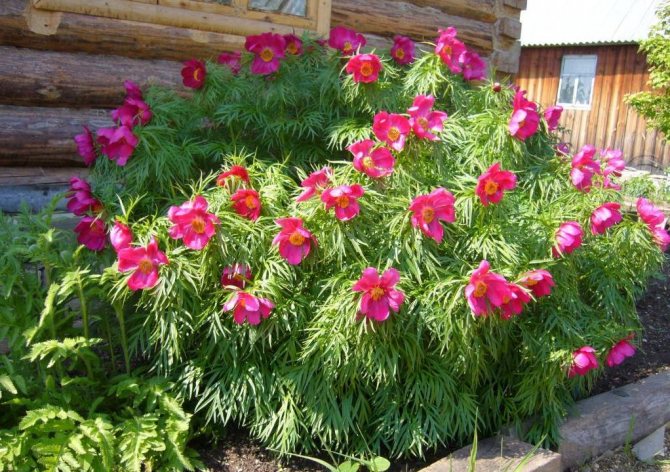

Maryin root can grow in one place for decades
Seed planting
This breeding method is very painstaking. Seeds are stratified at home for 7.5 months.To do this, they are placed in a small container filled with wet sand and stored for 2.5 months at a temperature of 20 ⁰C. For the remaining 5 months, the seed should be in the refrigerator. Next, the container is exposed to warmth and begins to water regularly - after a while, shoots will appear. The seedlings are transferred to open ground after 2 years.

